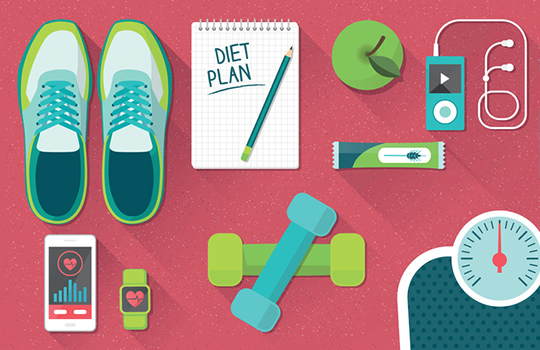
 Kate Womersley and Katherine Ripullone
Kate Womersley and Katherine Ripullone
Would you expect a junior doctor to be confident giving basic advice and care for the most common and fatal diseases? Of course you would. NICE guidelines state that a first line intervention for diabetes, obesity, and high cholesterol (all major risk factors for cardiovascular disease and early mortality) is to give “lifestyle advice,” but this is a phrase so vague that it leaves it for doctors and patients to define it and, potentially, ignore it.
In 2008 and 2009, more than 75% of American junior physicians felt inadequately trained to counsel patients on diet and physical activity. [1] The picture is reportedly similar in the UK. [2] In Tomorrow’s Doctors, the GMC requires qualifying medical students to understand the role of diet in health promotion and disease prevention, which includes being nutritionally competent. Internationally, this knowledge is lacking in medical training. Just 27% of US medical schools indicated that they provided the agreed minimum 25 hours of nutrition education in 2008. [3] A recent study of European medical schools was slightly more optimistic, suggesting that nutrition education was a requirement in 68.8% of institutions surveyed, with an average of 23.68 hours of teaching. [4]
This, however, has not been our experience at medical school in the UK, where nutrition education has been notably lacking. It is not that students don’t want to learn this material. If individual universities had the courage to lead the way in preventative nutrition, the majority of medical students would be only too keen to learn more about this subject.
Nutrition science regrettably suffers from an image problem in medical practice. This starts with its subordination in curricula and qualifying exams. Dietary interventions are considered to be outside of the evidence base, unscientifically “fluffy,” and the domain of dieticians rather than doctors. Medical students first hear about nutrition in biochemistry lectures regarding specific metabolic pathways abstracted from disease mechanisms or patient experiences. In later clinical years, the details of healthy diets, ways to assess malnutrition, or specific food requirements for particular diseases in hospital and community settings are glossed over.
Medical students are routinely presented with evidence for pharmaceutical decision-making, but rarely empirical data about the impacts of nutrition or exercise (of course, there is also the problem that less evidence in this field is available). This undervaluation of nutritional knowledge continues when it comes to professional expectations. It is rightly required that doctors stay up to date with the continuously revised NICE guidelines in specialties such as oncology. This ongoing learning is seen as a mark of medicine’s progress. But changes in nutritional guidance seem to be considered symptomatic of the field’s instability and lack of scientific certainty. Why in the case of nutrition science is amendment not expected, but rather belittled?
Knowing exactly what we mean by “improving patients’ diet and lifestyle”—being clear on what the message is—would enable doctors to focus on how they counsel patients, personalised to comorbidities, individual cultures, and characters. While the central aim here should not be to save money, if NHS doctors become more effective and efficient at giving lifestyle advice, the opportunity to prevent disease on an impressive scale would free up resources.
Other medical systems have made attempts to address inadequacies in nutrition education. The American College of Preventive Medicine (ACPM) introduced a “lifestyle medicine core competencies program,” and in 2009 Harvard Medical School established a student and faculty led curriculum in lifestyle medicine.
Physical activity and nutrition have recently become a focus in developing countries due to the observed rise in chronic diseases. Lifestyle interventions are earning a reputation as cost effective and clinically useful, as well as being realistic ways to cope with an increasing burden of disease. Recent research in west Africa found that medical schools that teach nutrition (67% of the total) dedicated 57 hours to such content.[5] In 2012, Nigeria adopted a new MBBS curriculum with an emphasis on human nutrition. These admirable advances could prove to be another case of “global health at home,” whereby practices developed in a setting of resource scarcity become increasingly attractive in the West.
The UK should be prioritising nutrition and lifestyle education in a similar way. Our government aims to prevent tens of thousands of premature deaths from heart disease and cancer by 2020. Nutrition could indeed be—as NICE envisions—a first line intervention to tackle these conditions, if only dietary advice were more accessible in primary care settings. Currently, a patient must be referred to see a dietician, and GPs can justify this referral only if a patient is experiencing serious risks or sequelae from a nutritionally related disease.
Therefore, expert nutritional advice in the NHS is, by default, interventional. It is a response to pathogenesis, rather than a prophylactic part of “salutogenesis” (the creation and maintenance of health and wellbeing). Although weight is a modifiable risk factor for early morbidity and mortality, the way that the NHS is structured and the training given to students and juniors undermines this opportunity for change.
Katherine Ripullone and Kate Womersley are final year graduate medical students at the University of Cambridge. They both worked in medical humanities previously, and have an interest in how clinical education interacts with society.
Competing interests: None declared.
[1] Matthew D Levy, Lisel Loy, and Laura Y Zatz
Policy approach to nutrition and physical activity education in health care professional training, Am J Clin Nutr 2014 ajcn.073544; First published online March 19, 2014. doi:10.3945/ajcn.113.073544
[2] Reported by the BBC in 2010 and again by The Guardian in 2016: http://news.bbc.co.uk/1/hi/health/8572874.stm, https://www.theguardian.com/society/2016/oct/19/doctors-know-too-little-about-effects-of-nutrition-and-exercise [accessed Aug 23 2017]
[3] Adams, K., Kohlmeier, M. and Zeisel, S. (2010). Nutrition Education in U.S. Medical Schools: Latest Update of a National Survey. Academic Medicine, [online] 85(9), pp.1537-1542. Available at: https://www.ncbi.nlm.nih.gov/pmc/articles/PMC4042309/ [Accessed 3 Mar. 2017].
[4] Chung, M., van Buul, V., Wilms, E., Nellessen, N. and Brouns, F. (2014). Nutrition education in European medical schools: results of an international survey. European Journal of Clinical Nutrition, [online] 68(7), pp.844-846. Available at: https://www.nature.com/ejcn/journal/v68/n7/full/ejcn201475a.html [Accessed 3 Mar. 2017].
[5] Sodjinou, R., Bosu, W., Fanou, N., Déart, L., Kupka, R., Tchibindat, F. and Baker, S. (2014). Nutrition training in medical and other health professional schools in West Africa: the need to improve current approaches and enhance training effectiveness. Global Health Action, [online] 7(1), p.24827. Available at: https://www.ncbi.nlm.nih.gov/pmc/articles/PMC4119290/ [Accessed 3 Mar. 2017].
